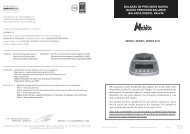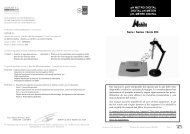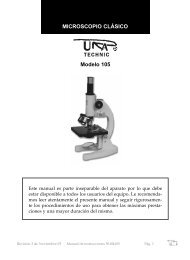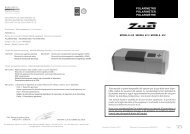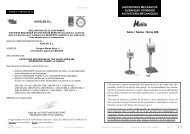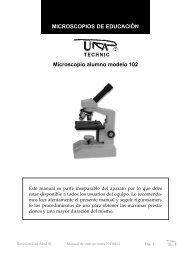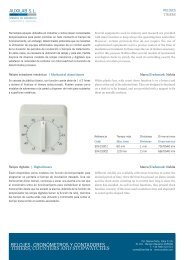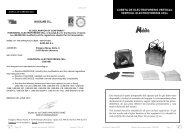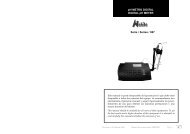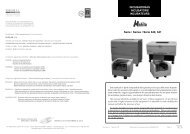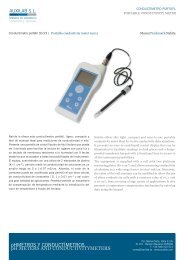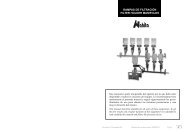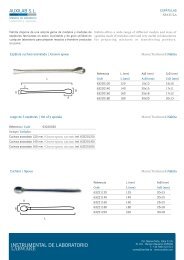MICRÃTOMO DE ROTACIÃN ROTATION MICROTOME ... - Auxilab
MICRÃTOMO DE ROTACIÃN ROTATION MICROTOME ... - Auxilab
MICRÃTOMO DE ROTACIÃN ROTATION MICROTOME ... - Auxilab
Create successful ePaper yourself
Turn your PDF publications into a flip-book with our unique Google optimized e-Paper software.
ENGLISH<br />
wheel must be always locked before changing the sample as well as during all work<br />
breaks.<br />
• Move the holding device for sample clamp (1.12) to the uppermost position; for this<br />
purpose, turn the manual handwheel (1.10) and lock it by the device located at the lower<br />
side (1.11).<br />
• Insert the cassette horizontally or vertically into the sample clamp. For this purpose,<br />
pull forward the expelling lever (1.15) and place the cassette. Release the lever to secure<br />
the cassette in position.<br />
5.2 Placing the knife<br />
Nahita microtome 591 is equipped with a knife holder for standard disposable blades<br />
of common use.<br />
NOTE: Be careful when handling disposable blades for microtome. The blade edge is<br />
extremely sharp and can cause severe injuries<br />
• Turn upwards the knife holding clamp (1.5).<br />
• Carefully insert the disposable blade from one side into the knife holder.<br />
• To hold the knife, turn downwards the holding clamp (1.5).<br />
• Pay attention to the blade edge; replace the knife when the obtained sections present<br />
scratches that could make them useless.<br />
5.3 Adjusting the clearance angle<br />
The marks (0º, 5º and 10º) for clearance angle adjustment (1.6) are on the right side of<br />
the knife holder. Another mark is on the right side of the knife holder base which serves<br />
as a reference point to select the desire angle.<br />
• Rotate anticlockwise the clamping lever for knife holder (1.3) to release.<br />
• Adjust the knife holder position until the selected mark matches the reference mark on<br />
the knife holder base.<br />
• Hold the knife holder at this position and turn clockwise the camping lever (1.3) to secure<br />
it.<br />
5.4 Sample orientation<br />
Orientation system of the sample holder allows adjusting the position of the block surface<br />
without having to release the clamping lever.<br />
• Unlock the coarse feed knob (1.8) by turning to the right the locking lever (1.9).<br />
• Rotate the coarse feed knob and make advance the knife holder base with the knife holder<br />
until nearly reaching the sample.<br />
• Move the holding device for sample clamp (1.12) to the uppermost position and lock the<br />
manual handwheel.<br />
• Release the locking lever of the orientation system (1.18) by turning downwards.<br />
CASTELLANO<br />
NOTA: siempre monte primero la muestra y después la cuchilla.<br />
Siempre se debe bloquear el volante manual antes de cambiar las muestras así como<br />
durante las pausas de trabajo.<br />
• Coloque el dispositivo de sujeción para las pinzas porta-casetes (1.12) en el punto más<br />
alto; para ello gire el volante manual (1.10) y bloquéelo mediante el dispositivo de seguridad<br />
situado en su parte inferior (1.11).<br />
• Inserte el casete en posición horizontal o vertical en la pinza porta-muestras. Para ello,<br />
tire hacia delante de la palanca expulsor de casetes (1.15) y coloque el casete. Suelte la<br />
palanca para que el casete quede sujeto.<br />
5.2 Colocación de la cuchilla<br />
El microtomo Nahita 591 está equipado con un porta-cuchillas para cuchillas desechables<br />
de uso corriente.<br />
NOTA: Cuidado al manejar cuchillas desechables de microtomo. El filo es muy agudo,<br />
podría cortarse fácilmente.<br />
• Gire hacia arriba la palanca de sujeción de la cuchilla (1.5).<br />
• Inserte la cuchilla desechable cuidadosamente desde un lado en el porta-cuchillas.<br />
• Para sujetar la cuchilla gire hacia abajo la palanca de sujeción (1.5).<br />
• Preste atención al filo de la cuchilla; sustituya la cuchilla cuando vea que se producen<br />
rayas en los cortes obtenidos que pueden llegar a fragmentar todo el corte y hacer que<br />
deban ser desechados.<br />
5.3 Ajuste del ángulo libre<br />
Las marcas (0º, 5º y 10º) para el ajuste del ángulo libre (1.6) se encuentran en el lado<br />
derecho del porta-cuchillas. En el lado derecho de la base porta-cuchillas se encuentra otra<br />
raya índice que sirve como punto de referencia para seleccionar el ángulo.<br />
• Afloje la palanca de sujeción del porta-cuchillas (1.3) girándola en sentido de las agujas<br />
del reloj.<br />
• Ajuste el porta-cuchillas, orientándose hasta que la raya deseada coincida con la raya de<br />
referencia en la base porta-cuchillas.<br />
• Mantenga el porta-cuchillas en la posición seleccionada y sujetándolo gire la palanca<br />
(1.3) en sentido de las agujas del reloj.<br />
5.4 Orientación de la muestra<br />
• El sistema de orientación del porta-muestras permite ajustar la posición de la superficie<br />
de la muestra sin tener que aflojar la palanca de sujeción.<br />
• Desbloquee el mando de avance macro (1.8) girando la palanca de bloqueo (1.9) hacia<br />
la derecha<br />
• Gire el mando de avance macro y haga avanzar la base porta-cuchillas junto con el<br />
porta-cuchillas hasta que se encuentre justamente delante de la muestra.<br />
• Coloque el dispositivo de sujeción para las pinzas porta-casetes (1.12) en el punto más<br />
alto y bloquee el volante manual.<br />
Page 18 Instruction manual 50591000 Version 1 February-07<br />
Revisión 1, Febrero-07 Manual de instrucciones 50591000 Pág. 7



